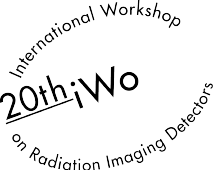Speaker
Description
Particle counting detectors with Microchannel Plates (MCPs) have been successfully used in various applications ranging from astrophysical imaging, where incoming fluxes are relatively low, to synchrotron instrumentation and neutron imaging with input fluxes exceeding 10^8 cm^-2s^-1. Among the attractive capabilities of MCPs is their ability to convert an incoming particle into 10^3-10^7 electrons within single or several adjacent pores, enabling imaging with spatial resolution as high as several micrometers through event centroiding. In such devices the center of gravity is calculated for each electron cluster registered by a certain readout, providing individual events are separated spatially or temporally. However, the detection efficiency in such devices is reduced compared to non-centroiding configurations as some events are rejected by the processing electronics (e.g. events with footprint being too narrow). That reduction of detection efficiency is strongest for applications where incoming particles are absorbed within the bulk of the MCP glass (such as gamma and neutron detection), not just its front surface, leading to substantial variation of gain between different events.
In this paper we demonstrate the possibility to compromise between the detection efficiency and the spatial resolution by acquiring several images simultaneously: one with the best spatial resolution, but reduced statistics, and the others with more events accepted, but a lower spatial resolution, with the lowest resolution defined by a single pixel/strip width of the readout. The results presented in the this paper are obtained with a quad Timepix parallel readout with 512x512 pixels encoding events produced by a chevron stack of MCPs. The highest spatial resolution image (down to single MCP pore spacing of 7.2 µm) is acquired simultaneously with the image where resolution is defined by the readout pixel size of 55 µm, where no events are rejected. The challenge of real time data analysis is addressed by the implementation of multicore parallel processing in order to cope with multi-MHz event rates. The ability to acquire high resolution and high statistics images simultaneously increases the flexibility of data analysis and may be very attractive for applications where a compromise between spatial resolution and detection efficiency must be determined before the experiment.
